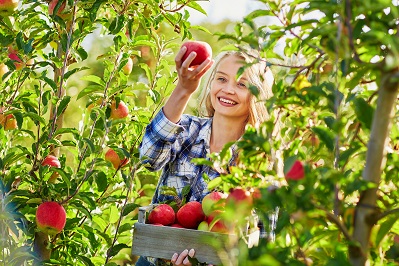Growing conditions can vary around Australia. If you have any queries please contact your local Independent Garden Centre.
How To Grow Fruit Trees.
Fruit trees not only provide luscious, fresh fruit but they also provide beauty and colour too. This leaflet will give you information on planting and growing deciduous fruit trees. Citrus trees are covered in another leaflet.
BRIEFLY:
Situation: Most fruit trees require sun for most of the day.
Height & Width: Varies, depending on variety, pruning etc.
There’s really nothing to equal the taste of home-grown fruit picked fresh from your own garden and there’s really no reason why you can’t grow them. We have the traditional varieties plus the newer dwarf ones, the columnar ones and even some suitable for pots. There’s a fruit tree for nearly any garden.
Where to Plant?
Fruit trees need a sunny spot, a well drained soil and good consistent watering to ensure a healthy crop of fruit. Your fruit, after all, is totally dependent on water for its quality and texture.
Whether you plant in your back yard or front garden is entirely up to you and many. fruit trees make wonderful feature specimens.
When to Plant?
Plant at any time. The best range of fruit trees is available from June to August but we do have a selection of the more popular varieties available in pots most of the year.
SELECTING THE SITE & PREPARING THE SOIL
Fruit trees prefer an open, sunny well drained situation and reasonable garden loam -. Careful preparation of the ground, by digging in well composted organic matter about three weeks prior to planting, is beneficial. Do not add fertiliser at this stage unless it is a special planting food. You might burn the roots.
Heavy clay soils should be improved by digging in Gypsum 2-3 weeks prior to planting or by the use of Clay Breaker.
SELECTING THE VARIETY & PLANTING
Most varieties of deciduous fruit trees need another variety that flowers at the same time for cross pollination and fruit set eg. an apple requires another variety of apple nearby to ensure fruit.
You will often find that one tree will crop without you planting another variety but this is generally because there is another compatible tree nearby in a neighbours garden and bees are providing the pollination. It is, however, much safer to plant two trees yourself.
Certain trees such as Apricots, Nectarines, Quinces and most Peaches do not require cross pollination and one tree is enough.
It’s not really confusing
PLANTING: As with any plant, you’ll have better success if you prepare your soil before planting.
Bare-root Fruit Trees (Winter only). Trim off damaged roots or shoots and stand plant in a bucket of water with added Plant Starter. Dig a hole big enough to easily accommodate the roots and make a mound in the middle. Place the roots around the mound with the graft union above the soil level – you’ll see a soil mark on the stem and this should be at upper ground level after planting. Fill in around the roots with compost enriched soil, gently firming in as you plant. Water in well with Plant Starter to settle in the soil and lessen planting shock. Add more soil if needed. You should finish up with a slight ‘dished’ surface around the plant to assist watering.
Potted Fruit Trees: Remove the plant from the pot but do not disturb the roots too much, especially if the plants are freshly potted. Dig a hole twice the width of the root ball and slightly deeper than the root balls depth. Blend the soil you removed with Organic Planting Compost , 2/3 compost to 1/3 soil and partially fill the bottom of the hole with compost enriched soil. Place the root ball in the middle of the hole ensuring that the top of the root ball is level with the surrounding soil surface. Ensure that the graft union is above soil level. Fill compost improved soil back into the hole, firm down to exclude any air pockets and leave a dished finished surface. Water in straight after planting and add Plant Starter to help your plant to a better start in life by gently stimulating the root system.
N.B. Do not dig below the clay line in heavy soils as you may cause a drainage problem. Build up the soil level instead.
MAINTENANCE AFTER PLANTING
Mulching: After planting, mulch soil surface with an 8-10cm layer of quality mulch. To avoid collar rot, ensure that the mulch is not in direct contact with the stem.
Watering: Water new plantings in well. Fruit Trees require regular, deep watering initially through warmer months. A rough guide is two waterings of about 2-4 hours each week but this will vary with weather and soil conditions.
FEEDING: Do not feed Fruit Trees at planting time, it is far better to let them settle in for a few weeks. Feed with Grow Better All Purpose Plant Food in early Spring, early Summer & late Summer. The feeding roots of Fruit Trees are located under the outer foliage canopy, or drip line, so ensure the fertiliser is evenly spread over this area. Always water well prior to and after fertiliser application.
PRUNING: Fruit Trees perform at their best if pruned each year in Winter. Basically you aim to shape the plant, removing old or damaged wood to create new growth for fruiting. We suggest you obtain a Fruit Tree Pruning Leaflet for further advice.
© Garden Centres Association Australia Inc.








